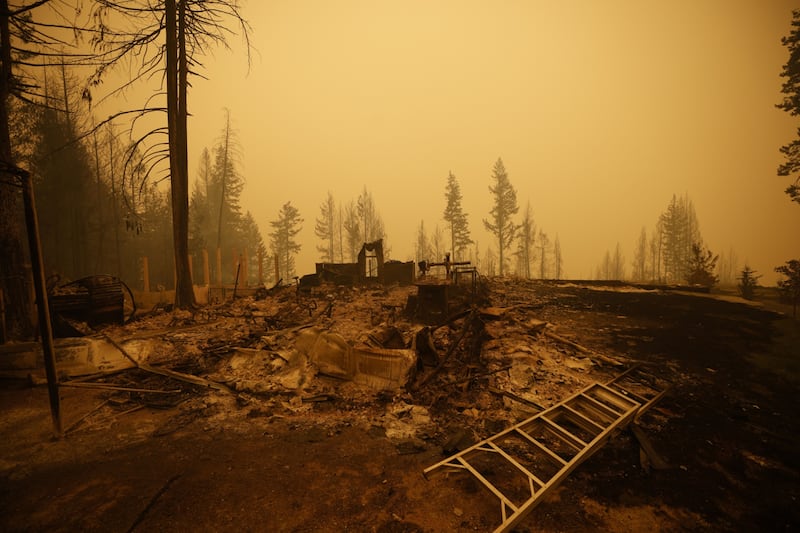Firefighters have kept wildfires at bay near the capital of Canada’s Northwest Territories as well as a city under threat in British Columbia, though no one claimed victory as forecasters warned that drier and windier weather was coming.
For Saturday at least, the weather was milder, providing some help for fire teams battling to contain the flames of Canada’s worst fire season on record that destroyed structures, fouled the air with thick smoke and prompted evacuation orders for tens of thousands of residents.
Officials said a huge wildfire again had been kept from advancing closer than nine miles from Yellowknife, the capital of the Northwest Territories that was left virtually empty when nearly all of its 20,000 residents fled for safety.
“We’re by no means out of the woods yet,” said Mike Westwick, wildfire information officer for the city. “We still have a serious situation. It’s not safe to return.”
Hebrew graffiti and a mass funeral in a Lebanese village on the Israeli border
Israeli security services point finger at Netanyahu as they own up to errors over Hamas’s October 7th incursion
Turkey’s Erdogan makes risky bet on peace with Kurds
‘We’ll rest when we win’: No let-up for Ukraine’s medics and rescue teams as war with Russia grinds on

To the south, in British Columbia, raging flames were also kept away from Kelowna, a city of 150,000 people about 140km north of the United States border.
The Kelowna fire is among more than 380 blazes across the province, with 150 burning out of control. The blaze near Yellowknife is one of 237 wildfires burning in the Northwest Territories.
At a Saturday evening news conference, Shane Thompson, the minister of environment and climate change for the Northwest Territories, said the fires near Yellowknife had not grown very much in the past few days thanks to breaks in the weather.
“But I want to be clear, a little bit of rain doesn’t mean it’s safe to come back home,” he said. Others warned that incoming hot weather would make the battle more challenging.
Yellowknife mayor Rebecca Alty encouraged residents to stay away to ensure their safety and help with firefighting efforts. She assured people that patrols were monitoring streets and homes to protect against looting.
The city has become a virtual ghost town since residents fled after an evacuation order was issued on Wednesday evening.
Long caravans of cars choked the main highway and people lined up for emergency flights to escape the blaze. The last 39 hospital patients were flown out on Friday night on a Canadian Forces plane, officials said.
On Saturday, officials said the escape route out of Yellowknife was safe, for the time being. About 2,600 people remained in town, including emergency teams, firefighters, utility workers and police officers, along with some residents who refused to leave.

Meanwhile, improved weather conditions helped firefighters make advances overnight in their battle to tame a wildfire raging out of control for the past five days on the tourist island of Tenerife in Spain’s Canary Islands, authorities said on Sunday.
“The night was very difficult but thanks to the work of the firefighters, the results have been very positive,” Tenerife governor, Rosa Davila said at a news conference on Sunday.
Although the blaze in the northeast of the island is not near the main tourist areas in the southwest, the regional government ordered the evacuation of a state-run hotel in the Teide volcano national park, in central Tenerife, some 48km southwest of the fire zone. It was not immediately clear how many people were staying at the hotel.
Ms Davila said that more than 12,000 people have been evacuated from their homes since the fire started on Tuesday.
The islands’ emergency services said on Sunday that 11,600 hectares of pine forest and scrubland had been burned.
No injuries have so far been reported and Ms Davila said that thanks to the firefighters, no houses have been burned so far.
Canary Islands regional president Fernando Clavijo said on Sunday that police have confirmed that the fire was started deliberately.
The fire, described as the worst in Tenerife in decades, is threatening 11 town areas flanking the steep and craggy mountain area affected. Access for firefighters is extremely difficult.
The emergency services said air quality in 19 town areas was not good and urged people to stay indoors when possible and wear masks outdoors.
More than 400 firefighters and soldiers have been deployed, as well as 23 water-carrying helicopters and planes.
The Canary Islands have been in drought for most of the past few years, just like most of mainland Spain. The islands have recorded below-average rainfall in recent years because of changing weather patterns impacted by climate change.
Spain’s mainland is bracing for another heatwave starting on Sunday. Spain’s state weather service issued a warning on Saturday that temperatures would be on the rise in the coming days, hitting 40 degrees in parts of the mainland. – AP












